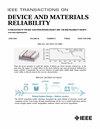Unit-Cell-Based Approach for Electromigration Compliance Checks in VLSI Power Delivery Networks
IF 2.3
3区 工程技术
Q2 ENGINEERING, ELECTRICAL & ELECTRONIC
IEEE Transactions on Device and Materials Reliability
Pub Date : 2025-03-02
DOI:10.1109/TDMR.2025.3566054
引用次数: 0
Abstract
As the electromigration (EM) reliability margin reduces rapidly with scaling, novel approaches for EM-compliance checks are being intensively sought to enable more accurate and less conservative analyses. Currently, chip-level EM reliability is assessed based on the failure probability of individual lines and vias in the BEOL stack, overlooking potential redundant connections that could still ensure circuit operation despite isolated failures. This is particularly relevant for the power delivery network (PDN), which is redundant by definition due to its regular mesh structure. In this work, we leverage a new approach to perform EM-compliance checks that relies on considering the PDN as a matrix of identical network units-cells, henceforth referred to as tiles, and using them to compute the overall failure risk. As opposed to conventional methods, our approach captures the impact of redundancy within each individual PDN tile, thereby providing less conservative reliability estimations. After reviewing standard methods for EM-compliance checks, namely limit-based and statistical EM budgeting (SEB), we quantify the additional reliability margin provided by our PDN-tile approach. For our analysis, we considered a PDN featuring three different metallization schemes for Dual Damascene (DD) Cu/Low-k interconnects utilizing SiCN capping, Cobalt (Co) capping with and without Ruthenium (Ru) via prefill. Using the standard SEB method indicated that Co capping and Co capping + Ru Via Prefill lead to reductions in EM failure risk by 5 and 7 orders of magnitude, respectively, compared to SiCN capping. The new approach was implemented for the first metallization with SiCN capping. At 10 years lifetime, our PDN-tile approach foresees a failure probability which is 3 orders of magnitude smaller than the SEB approach. At an equivalent failure probability of 100ppm and the same target lifetime of 10 years, the current of standard cells can be increased by 2.8-fold, giving designers more margin to improve chip performances.基于单元的VLSI输电网络电迁移符合性检测方法
由于电迁移(EM)的可靠性裕度随着规模的扩大而迅速降低,人们正在积极寻求新的EM符合性检查方法,以实现更准确、更保守的分析。目前,芯片级电磁可靠性的评估是基于BEOL堆栈中单个线路和过孔的故障概率,忽略了潜在的冗余连接,这些连接在孤立故障的情况下仍然可以确保电路运行。这与电力输送网络(PDN)特别相关,由于其规则的网格结构,PDN在定义上是冗余的。在这项工作中,我们利用一种新的方法来执行em合规性检查,该方法依赖于将PDN视为相同网络单元-单元的矩阵,因此称为单元,并使用它们来计算整体故障风险。与传统方法相反,我们的方法捕获了每个PDN块中冗余的影响,从而提供了更保守的可靠性估计。在回顾了电磁符合性检查的标准方法,即基于限制和统计电磁预算(SEB)之后,我们量化了PDN-tile方法提供的额外可靠性裕度。在我们的分析中,我们考虑了一种具有三种不同金属化方案的PDN,用于双Damascene (DD) Cu/Low-k互连,利用SiCN封盖、钴(Co)封盖和不通过预填充的钌(Ru)。使用标准的SEB方法表明,与SiCN封盖相比,Co封盖和Co封盖+ Ru Via Prefill分别降低了5个和7个数量级的EM失效风险。新方法用于第一次SiCN封盖的金属化。在10年的寿命中,我们的PDN-tile方法预测的失效概率比SEB方法小3个数量级。在100ppm的等效失效概率和相同的目标寿命为10年的情况下,标准电池的电流可以增加2.8倍,为设计人员提供了更大的空间来提高芯片性能。
本文章由计算机程序翻译,如有差异,请以英文原文为准。
求助全文
约1分钟内获得全文
求助全文
来源期刊

IEEE Transactions on Device and Materials Reliability
工程技术-工程:电子与电气
CiteScore
4.80
自引率
5.00%
发文量
71
审稿时长
6-12 weeks
期刊介绍:
The scope of the publication includes, but is not limited to Reliability of: Devices, Materials, Processes, Interfaces, Integrated Microsystems (including MEMS & Sensors), Transistors, Technology (CMOS, BiCMOS, etc.), Integrated Circuits (IC, SSI, MSI, LSI, ULSI, ELSI, etc.), Thin Film Transistor Applications. The measurement and understanding of the reliability of such entities at each phase, from the concept stage through research and development and into manufacturing scale-up, provides the overall database on the reliability of the devices, materials, processes, package and other necessities for the successful introduction of a product to market. This reliability database is the foundation for a quality product, which meets customer expectation. A product so developed has high reliability. High quality will be achieved because product weaknesses will have been found (root cause analysis) and designed out of the final product. This process of ever increasing reliability and quality will result in a superior product. In the end, reliability and quality are not one thing; but in a sense everything, which can be or has to be done to guarantee that the product successfully performs in the field under customer conditions. Our goal is to capture these advances. An additional objective is to focus cross fertilized communication in the state of the art of reliability of electronic materials and devices and provide fundamental understanding of basic phenomena that affect reliability. In addition, the publication is a forum for interdisciplinary studies on reliability. An overall goal is to provide leading edge/state of the art information, which is critically relevant to the creation of reliable products.
 求助内容:
求助内容: 应助结果提醒方式:
应助结果提醒方式:


